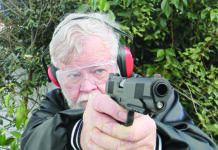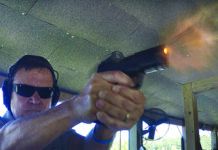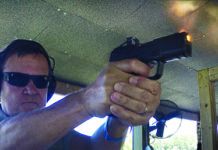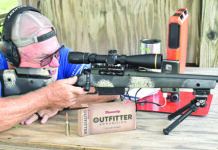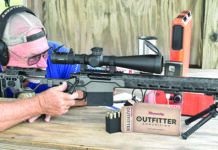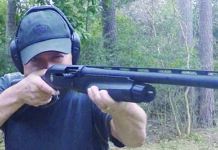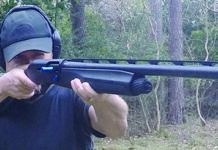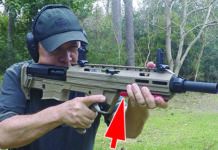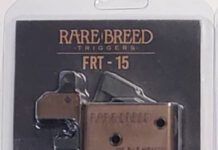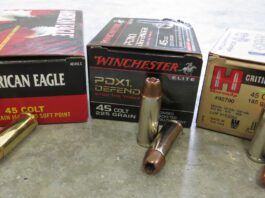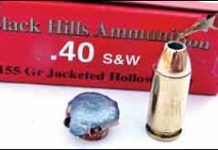Armscor Doubles Production Capacity To Meet U.S. Ammo Shortage
In the face of a national ammo shortage, Armscor USA and Armscor International have doubled their manufacturing capabilities and committed $4 million in new equipment and facilities.
2013 NRA Annual Meetings Open Tomorrow in Houston
The National Rifle Association’s 142nd Annual Meetings & Exhibits opens tomorrow at the George R. Brown Convention Center in Houston.
Civilian Ownership of Suppressors & Silencers: Steps in the Process
Silencers, like machine-guns, are regulated under the National Firearms Act (NFA) of 1934, and are regulated by the Bureau of Alcohol, Tobacco, and Firearms. The procedure for owning a silencer may seem daunting at first, but actually requires less paperwork than buying an automobile.
Brass vs. Steel Cased Ammo– An Epic Torture Test
Retailer LuckyGunner.com recently ran a massive ammunition comparison pitting steel and brass-cased 223 Rem. ammo in four AR-15s to catalog failures of all sorts.
Training Cartridges MeetAll SAAMI-Specs and Weights
Traditions Performance Firearms’ new Training Cartridges are the only training cartridges available that meet all SAAMI (Sporting Arms and Ammunition Manufactures Institute) specifications for dummy ammunition.
Federal Retools Premium Ammo Website
The new FederalPremium.com makes choosing the right ammunition quick and easy. Hunters and shooters can easily navigate the new website to find photography, educational graphics, and one-of-a-kind tools.
Winchester’s AA TrAAcker Shows Shot String Track
A fired 12-gauge shotgun shell unleashes a column of shot from a shotgun barrel at about 1,200 feet per second – too fast for the human eye to see the pellets in flight. This can make it extremely difficult to master the correct lead on flying clay targets or game birds. What if that changed? What if it was possible to track the flight of the shot string? Thanks to Winchester Ammunition, it’s happening in 2013.
Rock Island Armory Debuts TCM 22 Rifle
Rock Island Armory debuted the TCM 22 centerfire rifle at SHOT Show 2013. The new rifle is chambered for the Armscor TCM .22 cartridge exclusive to Armscor.
40 S&W Ammunition Tests: Black Hills 155s Are Best Buy
The history of American 10mm service cartridges is a bit strange. We began with the right idea, got off on a tangent, and returned to the right idea. The right idea is a short-case 40-caliber cartridge suitable for use in handguns previously deemed 9mm sized. The premise of a .400-inch bullet in a moderately sized handgun was begun with the 40 Guns & Ammo round about 1972. A Browning Hi-Power 9mm was converted to fire a special short-case cartridge made by shortening a rifle case and fitting on it a 180-grain bullet. The result had a velocity of about 1000 fps. The bullet used was the same diameter as the one in the 38-40 revolver cartridge. Experiments were promising. There was a lot of interesting experimentation in those days, and the 40 G&A and the 38 Super Cooper were worthwhile loadings.Somehow, the concept evolved into a longer cartridge with considerably more power. The 10mm auto could not be chambered in a 9mm-size handgun; instead it demanded a 45 ACP-sized frame. The 10mm Bren Ten debuted with a hot Norma loaded cartridge topping 1200 fps with a 200-grain bullet. The Bren Ten debacle is well documented. Colt resurrected the 10mm with the Colt Delta Elite, and the FBI first adopted then discarded the cartridge. Without shorting the many personalities and technicians involved, let us suffice to say that the 10mm was not the service cartridge of tomorrow, but it has survived with better distribution than the 41 Magnum, another round hailed as the police cartridge of tomorrow.Afterward, the 40 Smith & Wesson was developed and shoehorned into a 9mm-size handgun. The 40 S&W is much closer to the original concept. While early 40s beat themselves to death, the design eventually worked. The short case required a small primer instead of the large pistol primer used in the 10mm, largely because the cartridge case rides rather close to the 9mm size ejector. You simply do not need to have an ejector close to a large pistol primer - ditto for the 45 GAP, another innovation and shoe horn job. The 40 battered some 9mm-size handguns, and even today, many believe 40 S&W handgun life is shorter than 9mm and 45 ACP handguns. The 40 suffers pressure spikes according to respected authorities, and this may be the cause of several well documented 40 S&W blow ups. Another cause may be the heavy use of lead bullets in a polygonal barrel. We have learned not to do this as pressure builds rapidly. With a cartridge already running at the top tier in pressure, a bit of bore restriction is all it takes to push the pressure envelope over the edge. The 40 develops high pressure like the 9mm, but also has a heavy bullet that has more momentum, further stressing the action. The 40 isnt alone in this regard. When the 357 Magnum revolver was current, cops used tons of soft lead wadcutters in training. Firing a few jacketed Magnums to clean the bore often cracked the forcing cone. You simply have to keep the bore clean in a high-pressure-cartridge handgun.The bottom line most shooters want to get to is this: does the 40 Smith & Wesson offer enough advantages to overcome the shortfalls?
GOA: Biden Proposals Would Affect 50-80% of All Guns
Press reports now make it clear what Vice President Joe Biden’s gun control package will look like. Biden wants to impose:
Illinois Gun and Magazine Ban Measures Move Out of Committee
On Wednesday, Illinois Senate Democrats advanced bans on semiautomatic rifles and pistols and some magazines.
FBI Reports Record Gun Sales Last Month — Up 1 Million over December 2011
The Federal Bureau of Investigation said Wednesday that it had conducted a record number of instant background checks on those wishing to buy firearms in December



